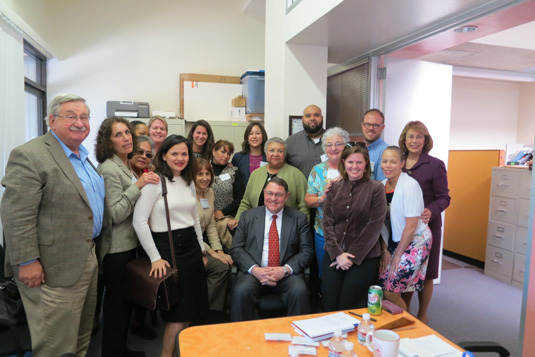Broadband Technology Opportunities Program
The Broadband Technology Opportunities Program (BTOP) is an approximately $4 billion grant program administered by NTIA to help bridge the technological divide; create jobs; and improve education, health care, and public safety in communities across the country. Funded by the American Recovery and Reinvestment Act of 2009, BTOP projects are deploying broadband Internet infrastructure, enhancing and expanding public computer centers, and encouraging the sustainable adoption of broadband service.
See also: NTIA's Recovery Act broadband programs
Related content
Remarks by Acting Chief of Staff Wilhelm at the 2014 Broadband Communities Summit
Remarks by Anthony Wilhelm
Acting Chief of Staff
National Telecommunications and Information Administration
2014 Broadband Communities Summit
Broadband, Economic Development and Global Competitiveness
Austin, Texas
April 10, 2014
--As prepared for delivery--
I. Be “Open for Business” in the Global Economy
NTIA Brings Broadband Opportunities to Alaska
Last week, I traveled to Anchorage for the annual economic summit hosted by the Southwest Alaska Municipal Conference, a non-profit regional economic development organization. The Southwest Alaska Municipal Conference is working to improve the quality of life and drive responsible development across the Alaska Peninsula, the Aleutian Islands, Bristol Bay, the Kodiak Archipelago and the Pribilof Islands.
Last week’s summit had a packed agenda, covering everything from energy conservation to sustainable fishing practices. One big topic of conversation was broadband and the power of high-speed Internet to open up economic, educational and social opportunities in some of the poorest, most isolated communities in our nation.
It’s no wonder that the Alaska state nickname is “The Last Frontier.” The state is more than double the size of Texas, with more than 3 million lakes, 34,000 miles of shoreline, and 29,000 square miles of ice fields. But with fewer than 750,000 residents, Alaska includes some of the most remote, sparsely populated pockets of the U.S. Many Alaska Natives reside in tiny villages with just a few hundred people and lead subsistence lifestyles.
Broadband offers these communities a way to connect with the wider world and access everything from online classes to healthcare services to job opportunities. It also offers Alaska Natives a way to preserve their indigenous culture for future generations and share it with a global audience.
Working to Close the Digital Divide in Silicon Valley
Silicon Valley has long been a hub of technological innovation and promise in our country. It’s the birthplace of iconic technology companies such as Intel, Apple, Cisco, and Google. And regions across the country – and even around the world – attempt to emulate its success.
This week, I joined Commerce Secretary Penny Pritzker and other Commerce Department leaders in travelling to Silicon Valley to promote the Department’s initiatives to spur U.S. economic growth, innovation, and competitiveness.
We’re meeting with leaders of technology powerhouses, fledgling start-ups, and venture capitalists funding the next big idea. Yet, we recognize that not everyone in the region has shared in the wealth created in Silicon Valley. Yesterday I had the privilege of meeting with a number of groups including the California Emerging Technology Fund (CETF), the Chicana/Latina Foundation, the Latino Community Foundation, and others that are working tirelessly across the state to close the digital divide.

Leaders from Silicon Valley-area community groups gather with Assistant Secretary Strickling to talk about bridging the digital divide.
